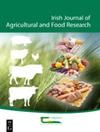Sensory and ATP derivative-based indicators for assessing the freshness of Atlantic salmon (Salmo salar) and cod (Gadus morhua)
IF 1.4
4区 农林科学
Q3 AGRICULTURE, MULTIDISCIPLINARY
引用次数: 5
Abstract
Abstract To estimate the shelf life of fresh fish, the processor must know the period of time between catch/harvest and arrival at the processing plant. This information is not always available, necessitating the provision of methods to estimate the time since catch or harvest. The objectives of this study were therefore to develop and/or validate sensory and ATP derivative-based methods for rapidly assessing the freshness of fish. A quality index method (QIM; raw fish) and a quantitative descriptive analysis (QDA; cooked fish) were developed and validated (against bacterial count [total viable count (TVC)] and time) for salmon (Salmo salar) and cod (Gadus morhua). The production of inosine monophosphate (IMP), inosine and hypoxanthine (Hx) and associated ratios (IMP/Hx, K1-value or H-value) were also investigated for use as freshness markers. There was a linear relationship between QIM and TVC (R2 = 0.93 for salmon and R2 = 0.89 for cod), QIM and time (R2 = 0.96 for salmon and R2 = 0.98 for cod), QDA and TVC (R2 = 0.93 for salmon and R2 = 0.77 for cod) and QDA and time (R2 = 0.94 for salmon and R2 = 0.87 for cod), suggesting that the QIM and QDA schemes developed could be used to monitor/assess freshness. The H-value also increased linearly with TVC (R2 = 0.88 for salmon and R2 = 0.89 for cod) and time (R2 = 0.93 for salmon and R2 = 0.84 for cod). It was therefore concluded that both the QIM/QDA approach and monitoring ATP degradation, specifically expressed as the H-value, could be used as rapid methods to assess the freshness of salmon and cod arriving at the processing plant.基于感官和ATP衍生物的大西洋鲑鱼和鳕鱼新鲜度评价指标
为了估计鲜鱼的保质期,加工人员必须知道从捕捞/收获到到达加工厂之间的时间。这一信息并非总是可用的,因此需要提供方法来估计自捕捞或收获以来的时间。因此,本研究的目的是开发和/或验证基于感官和ATP衍生物的方法,以快速评估鱼类的新鲜度。质量指数法(QIM);生鱼)和定量描述性分析(QDA;对鲑鱼(Salmo salar)和鳕鱼(Gadus morhua)的细菌计数[总活菌数(TVC)]和时间进行了开发和验证。还研究了肌苷一磷酸(IMP)、肌苷和次黄嘌呤(Hx)的产量及其相关比率(IMP/Hx、k1值或h值),作为新鲜度指标。qm与TVC(鲑鱼R2 = 0.93,鳕鱼R2 = 0.89)、qm与时间(鲑鱼R2 = 0.96,鳕鱼R2 = 0.98)、QDA与TVC(鲑鱼R2 = 0.93,鳕鱼R2 = 0.77)、QDA与时间(鲑鱼R2 = 0.94,鳕鱼R2 = 0.87)呈线性关系,表明所建立的qm和QDA方案可用于新鲜度监测和评价。h值随TVC(鲑鱼R2 = 0.88,鳕鱼R2 = 0.89)和时间(鲑鱼R2 = 0.93,鳕鱼R2 = 0.84)呈线性增加。因此,qm /QDA方法和ATP降解监测(具体表示为h值)都可以作为快速评估到达加工厂的鲑鱼和鳕鱼新鲜度的方法。
本文章由计算机程序翻译,如有差异,请以英文原文为准。
求助全文
约1分钟内获得全文
求助全文
来源期刊
CiteScore
2.50
自引率
20.00%
发文量
23
审稿时长
>36 weeks
期刊介绍:
The Irish Journal of Agricultural and Food Research is a peer reviewed open access scientific journal published by Teagasc (Agriculture and Food Development Authority, Ireland). Manuscripts on any aspect of research of direct relevance to Irish agriculture and food production, including plant and animal sciences, food science, agri environmental science, soils, engineering, buildings, economics and sociology, will be considered for publication. The work must demonstrate novelty and relevance to the field of research. Papers published or offered for publication elsewhere will not be considered, but the publication of an abstract does not preclude the publication of the full paper in this journal.

 求助内容:
求助内容: 应助结果提醒方式:
应助结果提醒方式:


